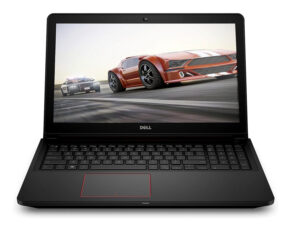The Top 5 Best Gaming Laptop – (2023) , Buying a gaming laptop is challenging as there are many options, with new models released every year sporting increasingly more powerful CPUs and GPUs. When shopping for the best gaming laptop, you’d want to focus on a few aspects, like its CPU and GPU performance, performance over time (thermal throttling), as well as the display’s refresh rate, motion performance, and VRR support. A good keyboard helps, too, as you’d want one that can give you clear tactile feedback and won’t cause fatigue over long gaming sessions. If you don’t plan on using a headset, you might want to look at the fan noise, as most gaming laptops can get pretty loud under load. If you plan on gaming on the go, you’ll also want to look at the laptop’s portability and battery life.
Dell Alienware M18 Best Gaming Laptops – (2023)
The best gaming laptop we’ve tested is the Dell Alienware m18 (2023). This 18-inch premium model provides a fantastic gaming experience at 1080p or 1440p. It’s available with fast AMD Ryzen 7000 CPUs and various discrete AMD and NVIDIA GPUs, up to an RTX 4090. Display options include a FHD+ 480Hz and a 165Hz QHD+ IPS panel, so you can choose whether you want smoother motion and better responsiveness or a sharper image. Even the keyboard is customizable, as you can get it with scissor or low-profile, clicky CherryMX mechanical switches. If you game online, you’d be happy to hear it has Wi-Fi 6E and an Ethernet port to ensure a reliable internet connection. The main downside is portability, as this is a bulky, heavy laptop that’s more of a desktop replacement than a device for on-the-go use. Also, the fans are very loud. You can get this laptop directly from Dell if you have trouble finding it elsewhere.
A more portable alternative would be the Razer Blade 14 (2022), also one of the best gaming laptops we’ve tested. It’s significantly thinner and lighter, so it’s easier to carry around, and it still packs plenty of processing power to push high frame rates in demanding games. The tradeoff is that this is an older model with NVIDIA 30-series GPUs, which lack Frame Generation, a feature that boosts frame rates by inserting artificially generated frames in supported games. Not many games currently support this feature, but as we’ve seen with DLSS, that number will likely grow quickly. There’s a newer 2023 model with RTX 40-series GPUs, which we haven’t tested but expect to be very similar; however, it’s more expensive. You can see the 2023 model here.
Lenovo Legion Pro 5 Gen 8 16 Best Gaming Laptops – (2023)
Our best gaming laptop pick in the mid-range tier is the Lenovo Legion Pro 5 Gen 8 16 (2023). Like our top pick, this 16-inch model is available with AMD Ryzen 7000 CPUs and NVIDIA GeForce RTX 40-series GPUs, though only up to an RTX 4070. You can get up to 32GB of RAM and 1TB of storage; both are user-replaceable. The base RTX 4050 GPU can push high frame rates in demanding games, but you may have to lower the settings or play at 1080p. If you want to play all of your games at the display’s native QHD+ resolution, it’s best to upgrade to a 4060 or 4070. As for the display, you have two refresh rate options: 165Hz and 240Hz. Both support VRR to reduce screen tearing.
The build quality is great. It doesn’t feel as premium as our top pick, but it feels sturdy. It has a tactile, full-size keyboard, Wi-Fi 6E wireless connectivity, and tons of ports, including an HDMI 2.1 and Ethernet. The fans get pretty loud, but on the upside, neither the CPU nor the GPU throttles under load, so you won’t get performance dips when playing for an extended period. Unfortunately, this laptop and its power adapter are bulky and heavy, and the battery lasts less than five hours of light use.
ASUS ROG Zephyrus G14 Best Gaming Laptops – (2023)
if you’re shopping on a more limited budget, consider the ASUS ROG Zephyrus G14 (2022). This all-AMD system sports an AMD Ryzen 9 6900HS CPU, and you can choose between an AMD Radeon RX 6700S or 6800S GPU. Both GPUs provide smooth gameplay in AAA titles at the display’s native QHD resolution. As for the display itself, the 120Hz IPS panel has a fast response time to deliver a clear image in fast-moving scenes and FreeSync support to reduce screen tearing.
The storage maxes out at 1TB, which isn’t very much considering the size of modern AAA games; however, it’s user-upgradeable. Ports include two USB-As, two USB-Cs, an HDMI, and an SD card reader. One last thing: there’s a newer (and more expensive) model of the G14 with AMD Ryzen 7000 CPUs and NVIDIA 40-series GPUs, and consequently, this 2022 model is often on sale at around $1,200 USD, so it’s a great time to pick one up.
Lenovo IdeaPad Gaming 3 Best Gaming Laptops – (2023)
The best laptop for gaming we’ve tested in the cheap category is the Lenovo IdeaPad Gaming 3 (2021). Though entirely plastic, this 15.6-inch model feels surprisingly sturdy, especially for a model in its price range. For a little over $800 USD, you can get a configuration with an AMD Ryzen 5 5600H CPU, an NVIDIA GeForce RTX 3050 Ti GPU, 8GB of RAM, and 512GB of storage. This CPU and GPU combination can deliver a solid 60 fps gaming experience at 1080p with most titles. 8GB of RAM isn’t ideal for gaming, and you’ll quickly run out of space with only 512GB of storage. Thankfully, you can upgrade these components yourself later on.
As for the display, this model sports a 120Hz IPS panel. Its response time is rather slow, but it’s still better than a basic 60Hz panel and supports VRR to reduce screen tearing. Unfortunately, this laptop does get hot and loud under load, and the battery lasts less than an hour when gaming, which is normal but still disappointing. One last note: cheaper variants are around $650 USD; however, those models have a GTX 1650 GPU, which doesn’t perform quite as well as the RTX 3050 Ti. It may be worth it if you only play lighter, less graphically-intensive games.
Acer Chromebook 516 GE Best Gaming Laptops – (2023)
The best gaming Chromebook we’ve tested is the Acer Chromebook 516 GE (2022). Unlike our picks above, this device runs Chrome OS, an operating system that isn’t typically associated with gaming, and it runs on its Intel CPU’s integrated graphics. It’s because it’s made for cloud gaming services like NVIDIA GeForce NOW. Cloud gaming means the processing takes place on NVIDIA’s server—or whichever company provides the service—and the image is streamed to your device, alleviating the need for powerful hardware. GeForce NOW is a paid subscription service; the laptop comes with a three-month trial.
The overall build quality is good, and while it’s on the bulkier side, it isn’t too heavy, so it’s still portable. Its 16-inch QHD+ display has a 120Hz refresh rate and a good response time, resulting in a clear image with minimal ghosting in fast-moving scenes. You get Wi-Fi 6E wireless connectivity and an Ethernet port, which is great, as cloud gaming performance highly depends on your internet connection. The keyboard feels spacious and tactile, doesn’t get hot under load, and has RGB backlighting. Unfortunately, its battery life is very short, at around six hours of light use or an hour of gaming.


